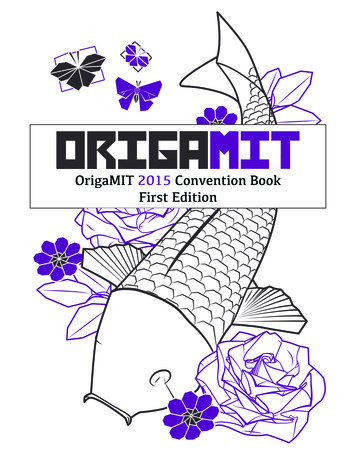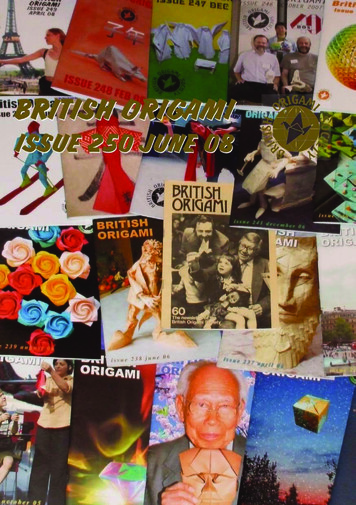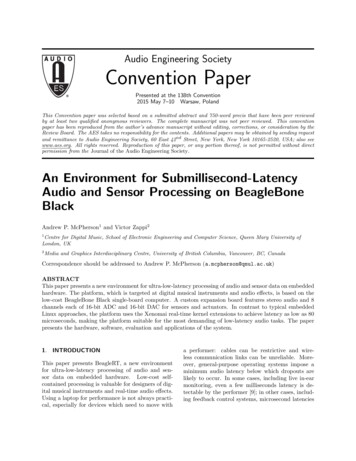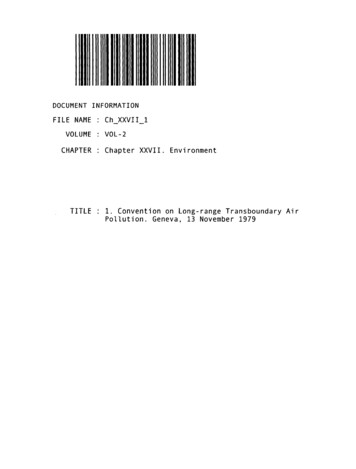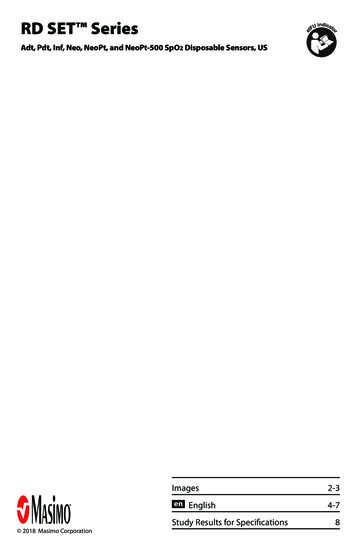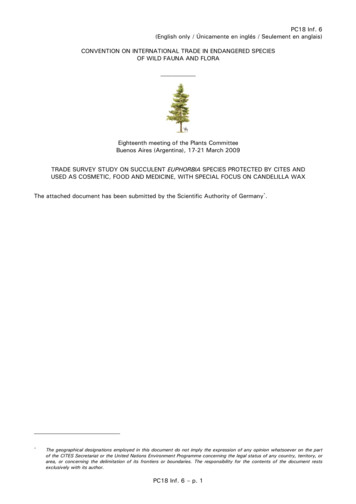
Transcription
PC18 Inf. 6(English only / Únicamente en inglés / Seulement en anglais)CONVENTION ON INTERNATIONAL TRADE IN ENDANGERED SPECIESOF WILD FAUNA AND FLORAEighteenth meeting of the Plants CommitteeBuenos Aires (Argentina), 17-21 March 2009TRADE SURVEY STUDY ON SUCCULENT EUPHORBIA SPECIES PROTECTED BY CITES ANDUSED AS COSMETIC, FOOD AND MEDICINE, WITH SPECIAL FOCUS ON CANDELILLA WAXThe attached document has been submitted by the Scientific Authority of Germany*.*The geographical designations employed in this document do not imply the expression of any opinion whatsoever on the partof the CITES Secretariat or the United Nations Environment Programme concerning the legal status of any country, territory, orarea, or concerning the delimitation of its frontiers or boundaries. The responsibility for the contents of the document restsexclusively with its author.PC18 Inf. 6 – p. 1
Trade survey study on succulent Euphorbia speciesprotected by CITES andused as cosmetic, food and medicine,with special focus on Candelilla waxDr. Ernst SchneiderPhytoConsulting, D-84163 MarklkofenCommissioned byBundesamt für NaturschutzCITES Scientific Authority, GermanyFebruary 2009ContentSUMMARY . 4OBJECTIVE. 5CANDELILLA WAX, ITS USE AND THE PLANT SOURCE . 6Candelilla wax . 6Current use . 6History of Candelilla use. 8Quality monographs . 9Definition of the plant source. 10Other species with potential use as Candelilla . 10CANDELILLA – ORIGIN, PRODUCTION AND SUSTAINABILITY. 14Natural distribution area . 14Harvesting area. 16Harvesting technique. 17Processing of Candelilla wax . 18Sustainability . 20Cultivation . 22TRADE FIGURES FOR CANDELILLA WAX . 23History of Trade. 23Current trade figures . 23Situation in Mexico. 23Export volume from Mexico . 26International trade figures . 27PC18 Inf. 6 – p. 2
Import into the European Union . 29Market in Germany . 30Imports into the USA. 31Market in the USA. 33Import to Japan. 34OTHER SPECIES OF THE GENUS EUPHORBIA WITH COMMERCIAL USE . 35Use as medicinal plants. 35Technical use of Euphorbia species . 37REFERENCES . 38PC18 Inf. 6 – p. 3
SUMMARYThe focus of this market survey review is on the use and trade amounts of Candelilla wax, obtained from thesucculent Euphorbia antisyphilitica from Mexico. Other Euphorbia species involved in trade as raw materials formedicinal, aromatic, cosmetic or other more technical uses are discussed.Finished products containing Candelilla wax from Euphorbia antisyphilitica, a CITES Appendix II species,require CITES permits. Since 2008, an increasing number of undocumented shipments were confiscated.Consignments of products containing Candelilla are shipped by the sounds, each of them requirung re-exportcertificates or import permits. This is burdensome for industry and authorities. This review investigates whetherthe monitoring of finished products containing Candelilla wax has conservation benefits.Euphorbia antisyphilitica is a shrubby spurge with its natural range extending from southwest USA (NewMexico and Texas) to Mexico, having densely clustered stems that yield the multi-purpose Candelilla wax. Itsdistinctive properties make it an essential raw material in a wide array of products, especially for cosmetics. Inorder to produce Candelilla wax the plant is collected from the wild. The wax is produced by boiling the pulledup entire stalks of the plant.For Candelilla production only the cuticula wax of Euphorbia antisyphilitica is used and not the white latex withtoxic properties. The demand during the 1940s was about 10-fold that of today. Certainly the natural resourcewas under stress by that harvesting intensity. At that time also other species of the Euphorbiaceae family likePedilanthus were used to produce Candelilla wax. Today this is obsolete because of quality reasons. Until theend of World War II also in southern States of the USA, Texas and New Mexico, the Candelilla plant washarvested. Today the main habitats in USA are protected by National Park.Today the demand of raw material on the international market is stable. The USA market is constant since1980 and EU imports are slightly decreasing since 2000, paralleled by a concurrent increase in the Japanesemarket. Data for export from Mexico are in good correlation with import data of the main importing countries.Within the EU and the USA the wax is processed widely into many different kinds of consumer products. Mainuser is cosmetic industry because of unique properties of the wax for lipsticks, mascara and eye liners. Forother purposes Candelilla wax is too expensive and suitable chemical materials are available to substitute thevegetable wax.Many cosmetic consumer product manufacturers are fearful of being criticised because of their involvementwith an endangered plant product and tend to substitute Candelilla for new product developments. The mid andlong term end result of these restrictions will be the decline of Candelilla Wax activity in an area of Mexicowhere the socio-economic conditions are already difficult.Harvest in Mexico is limited by a permit system of the Mexican authorities and sustainability will be enhancedby reforestation programs. It is unlikely that the present level of harvest will be a threat to Euphorbiaantisyphilitica at the species level. Cultivation of the plant is possible but until now only wild collected plantmaterial is used.Other Euphorbia species are used as medicinal plants. Due to the toxic properties of the latex of Euphorbiaspecies, only small quantities are used traditionally in origin countries and in homoeopathy in the Europeanmarket.The technical use of succulent Euphorbia species for production of rubber and gasoline is more of historicalinterest and did not exceed the experimental stage because until now the production remained uneconomic.For Candelilla wax extracted from Euphorbia antisyphilitica and exported from Mexico as raw material also infuture the CITES Appendix II listing should remain in place to enable Mexican authorities to control harvest andtrade and to enable conservation efforts. After the Candelilla wax has been legally exported and the rawcommodity processed into finished products it seems to be without any conservation effect when re-exportcertificates and import permits would be necessary for consumer products.According to currently available data the exemption of finished products in the generic listing of succulentEuphorbia species on CITES Appendix II will not be harmful and therefore could be supported. In order toresolve the increasing enforcement problems associated with the international trade in consumer productscontaining Candelilla wax as an ingredient it is suggested that the international community agrees on thefacilitation of trade in finished products made of Euphorbia antisyphilitica.PC18 Inf. 6 – p. 4
OBJECTIVEThe focus of this review will be the use and trade amounts of Candelilla wax, obtained from the succulentEuphorbia antisyphilitica from Mexico. Other Euphorbia species involved in trade as raw materials formedicinal, aromatic, cosmetic or other more technical uses will be discussed.Finished products containing Candelilla wax from Euphorbia antisyphilitica, a CITES Appendix II species,require CITES permits. Since 2008, an increasing number of undocumented shipments were confiscated.Consignments of products containing Candelilla are shipped by the sounds, each of them requirung re-exportcertificates or import permits. This is burdensome for industry and authorities. This review investigates whetherthe monitoring of finished products containing Candelilla wax has conservation benefits.In a proposal to the 14th meeting of the Conference of the Parties to CITES in 20071 it was proposed thatfinished products that are packaged and ready for retail trade (excluding whole or grafted specimens, seeds,bulbs and other propagules) of Euphorbia spp. should be exempted from CITES controls. This issue will bediscussed at the forthcoming 18th meeting of the Plants Committee (Buenos Aires, March 2009)The current review investigates whether an exemption of finished products for the species in the genericEuphorbia listing on Appendix II would be harmful or could be supported. To this end the following questionswill be answered and discussed:oooooo1Is Candelilla wax only sourced from E. antisyphilitica or also from other species?Is Candelilla wax exported from Mexico only as raw material or also as finished products?Are existing E. antisyphilitica populations in USA (Texas, New Mexico) not exploited, if so for exportreasons?Outline structure of Candelilla trade (countries of export, countries of import, commodities traded, typicalsize of consigments, frequency of trade transactions)Which other Euphorbia species involved in an hitherto unknown/unidentified trade as raw materials formedicinal, aromatic, cosmetic or other more technical uses? What is their use, trade volume, countries oforigin and import?For all species identified, assess the amount that comes from wild collection and artificial op/14/prop/E14-P26.pdf; see chapter 2.1 "Background" and 2.2 "Rationale"PC18 Inf. 6 – p. 5
CANDELILLA WAX, ITS USE AND THE PLANT SOURCECandelilla waxCandelilla wax consists, like other plant cuticula waxes, primarily of odd-numbered n-alkanes (C29 to C33),together with esters of acids and alcohols with even-numbered carbon chains (C28 to C34). Free acids, freealcohols, sterols, neutral resins, and mineral matter are also present.% 6-46.5Tritriacontane2.5Esters28-29Simple Esters and Lactones20-21Hydroxil Esters6-8%Alcohol, Steroles and Resins12-14Miricyclic alcoholNDSitosterol and other Sterols7-8Beta-Amirina Acetate5-6Free Acids7-9Linear Chain6-7CyclicNDHumidity0.5-1Inorganic Residues0.7Chemical Composition of Refined Candelilla WaxSource: http://www.Candelilla.org/propiedades.htmMore details on the composition of Candelilla wax and appropriate analytical procedures are available inIllmann (1979), Brossard (1994), and Regert (2005).Candelilla wax can potentially be used in a wide range of products because of its unique properties. It canharden other waxes without significantly increasing the melting point of the mixture (Candelilla Institute).Dispersions of Candelilla wax in fatty oil (e.g.safflower oil) results in formation of an organogel with textures ofpotential use by the food industry (Toro-Vazquez 2007).Current useCurrently used in more than 20 different industries worldwide, its distinctive properties make it an essential rawmaterial for the manufacturing of cosmetics, gum base, inks, dyes, adhesives, coatings, emulsions, polishesand pharmaceutical products. Main use today is in cosmetics, less amounts as ingredients in food,pharmaceutical products and wood finish.CosmeticsCandelilla is listed in INCI, the International Nomenclature of Cosmetic Ingredients of the EuropeanCommission, as cosmetic ingredient and therefore is to be named as CANDELILLA CERA in the labelleddeclaration of constituents.PC18 Inf. 6 – p. 6
Candelilla wax is used in cosmetics as emollient and film forming agent (Löhnert 1997). In general the market isdriven by consumer preference for ‘natural’ cosmetics, increasing the demand for natural waxes. Mostimportant cosmetic products containing Candelilla are Mascara, one of the most used cosmetic products,followed by lipstick and cosmetic pencil. Mascara is used to darken, lighten or colour lashes, also it can beused to thicken, lenghthen and define eyelashes. Usual composition is of soft surfactants, vegetal based waxes(Carnauba wax, Candelilla wax), pigments and thickening polymers.Lipsticks produced with Candelilla show lower tendency to sweating, a phenomen of oil excretion on thesurface of the lipstick after temperature fluctuation that is regarded as unattractive by consumer (Seo 1999). SoCandelilla is enhancing temperature stability and will prolong shelf life of the product without any change.Cosmetic pencils are used as lip-liners to make a contour and as eye liners and shadows. The lead base incosmetic pencil is a mixture of selected ingredients like oils and waxes. High-level products demand naturalingredients as Candelilla wax. They use especially Candelilla wax as raw material in the lead to strengthenthermo- stability of the pencils and provide long lasting contour lines (Mazgareanu 2004). For this specialpurpose Candelilla may not be substituted by other chemical substances or vegetable waxes because of itsspecial and unique properties. Candelilla is forming a special, partly crystalline structure to enclose otherwaxes, oils and pigments and to enhance stability and strength of the cosmetic pencil. This may bedemonstrated by 16 patents for cosmetic products with the ingredient Candelilla for one single company(Schwan-Stabilo, Germany, DEPATIS 2009).Use in foodAs food ingredient the wax should be listed on the product label as Candelilla wax (902), Candelillawachs orE 902.The Codex Alimentarius published by FAO is listing the possible uses:Functional Classeso Anticaking agent (release agent)o Bulking agento Emulsifier (clouding agent)o Glazing agento Carrier solventProvisions for Food Categoryo Chewing gumo Cocoa and chocolate productso Coffee, coffee substitutes, tea, herbal infusions, and other hot cereal and grain beverages, excludingcocoao Confectionery including hard and soft candy, nougats,o Decorations (e.g., for fine bakery wares), toppings (non-fruit) and sweet sauceso Fine bakery wares (sweet, salty, savoury)o Food supplementso Imitation chocolate, chocolate substitute productso Ready-to-eat savourieso Surface-treated fresh fruit GMPo Surface-treated fresh vegetables (including mushrooms and fungi, roots and tubers, pulses andlegumes, and aloe vera), seaweeds, and nuts and seedso Water-based flavoured drinks, including "sport," "energy," or "electrolyte" drinksIn the USA the FDA published a GRAS (“generally recognized as safe”) status for Candelilla as a direct humanfood ingredient (21 CFR Ch. I § 184.1976), establishing that the ingredient is used in food with no limitation.Based on current Good Manufacturing Practice conditions Candelilla may be used as a lubricant, surfacefinishing agent, in chewing gum and in hard candy.In fruit coating Candelilla seems not to be the best agent for apple coating compared to Carnauba and shellac(Bai 2003). On the other hand in orange coating, a mixture of Candelilla and polyethylene had advantages overshellac-wood resin coatings (Hagenmaier 2000). Today, applications in fruit coatings have mostly beenreplaced by petroleum derived waxes, particularly paraffin and microcrystalline waxes, which can also be foodgrade.PC18 Inf. 6 – p. 7
Candelilla also seems not to be the optimum wax component in chewing-gum as already stated in the 1950s(Hodge 1956). As the historical chart below demonstrates, chewing-gum is no longer the main use of Candelillain the USA like in the 1960s.Other sources list the use of Candelilla as food glazing agent, texturizer for chewing gum base, surfacefinishing agent for fruits, vegetables and bakery toppings, carrier for food additives (including flavours andcolours), clouding agent, or lubricant.Use in pharmacyIn pharmacy the wax is mostly used as lubricant in tablet manufacturing. In the German market only onecompany (Pfizer) is using Candelilla as excipient in coated tablets (Rote Liste online).Technical useCandelilla is used as wood finish for e.g. doors, artworks like violins, parquet floors, and for car polish.History of Candelilla useOverview on historical use of Candelilla waxSource: tmlPC18 Inf. 6 – p. 8
Recent trends in use of Candelilla wax are:o Over 90% is used in cosmeticso For other application Candelilla is too expensiveo Candelilla is added to products like polish and varnish in very small amounts to label the natural originof the consumer producto Replacement for other waxes is not profitable because of comparable price levelo Other waxes like Carnauba are more available on the international market(according to personal communication with traders).Quality monographsQuality monographs for Candelilla wax are published for pharmaceutical use in the USP (United StatesPharmacopoeia) and for food use in FCC (US Food Chemical Codex), FAO Additive-100 (Food & AgricultureOrganization), Japans Food Monographs and Korea Food Additives Code. Comparison of the specificationshows the narrow margins of quality parameters allowing only high grade Candelilla to be used for food andpharmaceutical purposes.MonographMelting SolubilityrangeAcid SaponiValue ficationValueUSP 32/NF2768.5 –72.5 CFCC5th ed68.5 –72.5 CFAOAdditive-10068.5 72.5 CKorea FoodAdditivesCodeHeavymetals12-22 43 - 65Accordingreference0,002%total,lead3ppm12-22 43 - 65Accordingreferencelead3ppm12-22 43 - 65Accordingreferencestandardlead2ppm68 73 C12.0 - 43 s Spe- 68cifications73 CandStandards forFoodAdditives200012-22 m,arsenic4ppmResidueafterignition0.3%.lightyellow tobrown31-43SpecificgravityImpurities ColorInfraredabsorptionInsolublein water;soluble erefore, Candelilla will not be easily substituted by other less expensive raw materials for manufacturing acertain high quality final product. Traditionally, the price of Candelilla wax had been 70 to 75 percent ofCarnauba type (de Guzman 2002) but in 2008 price for Candelilla was quite similar to usual qualities ofbeeswax and Carnauba wax (personal communication with German trader).Comparing quality parameters of the wax of Slipper Plant (Pedilanthus pavonis), also used as Candelilla wax inthe past, demonstrates that this source may not really be used for high quality Candelilla ueSpecific gravityPedilanthus pavonis64-68 C8-2146-670,941-1,002Candelilla wax from this plant source was found to be more resinous and with a lower melting range (Warth1956).PC18 Inf. 6 – p. 9
Definition of the plant sourceShoot and flower of Euphorbia antisyphiliticaSource: Frank Vincentz, www.euphorbia.deIn 1832, the botanist J. G. Zuccarini described the Candelilla plant for the first time with the scientific nameEuphorbia antisyphilitica (this is the original spelling for the plant name), recognizing the medicinal properties ofthe plant juices as a remedy used by the natives of the region for treating veneric diseases.A new classification of the Candelilla was presented in 1911 by G. Alcocer, who named it Euphorbia cerifera,highlighting the properties of the plant for making wax, which serves as a protective seal for the plant inretaining moisture.Euphorbia antisyphilitica Zuccarini 1832 ("1829/30"), Abh. math.-phys. Cl. König. Bayer. Akad. Wiss. 10:292 (“Euphorbia antisyphilitica”) Euphorbia cerifera Alcocer 1911, Anales Inst. Méd.-Nac. México 11: 155. Trichosterigma antisyphiliticum (Zuccarini) Small, s. a. Tirucallia antisyphilitica (Zuccarini) P. V. Heath, 1996This taxonomy follows Carter & Eggli (2003), the official CITES reference for succulent Euphorbia taxa. It alsouses information from R. Govaerts, World Checklist of Selected Plant Families (http://www.kew.org/wcsp/),GRIN, the National Plant Germplasm System (http://www.ars-grin.gov/ ), and Mansfeld s World Database ofAgricultural and Horticultural Crops (http://mansfeld.ipk-gatersleben.de/).Additional names of uncertain status:? Euphorbia rossiana Pax 1910, Rep. spec. nov. VIII 10/16, p. 161-162See http://bibdigital.rjb.csic.es/Imagenes/P0027 116/P0027 116 667.pdf? Euphorbia antisyphilitica J. Meyrán 2000, Cact. Suc. Mex. 45(3): 68-70 (fig 1, tab. 1).According to IPNI, the International Plant Names Index (http://www.ipni.org/ ), this species was describedfrom the region of Tepatepec in the state of Hidalgo.Other species with potential use as CandelillaIn the past several other plant species from the genus Pedilanthus were cited as source plants for Candelillawax.Actually, Candelilla wax is not commercially obtained from these species, but primarily from Euphorbiaantisyphilitica, which has higher quality wax than Pedilanthus species. Pedilanthus plants offer lower waxyields, as well as lower melting points and a lower saponification value, compared to the wax produced fromthe plants of the Euphorbia species.PC18 Inf. 6 – p. 10
Because of quality reason (see specification of food grade Candelilla wax) it is unlikely that these speciescurrently will be used for Candelilla wax production. Only during the World War II when the demand wasincreasing also Pedilanthus species were used for Candelilla wax production (Warth 1956)Pedilanthus aphyllus Boiss. ex Klotzsch & GarckeSyn: Tithymaloides aphyllum (Boiss.) KuntzeOnly one single record published. Steep hill slopes with much caliche outcrop, very alkaline, arid scrub, withgiant barrel cacti and Euphorbs of multiple genera. 2.2 mile NE of San Antonio Texcala on Hwy 125.No image available.Pedilanthus pavonis (Klotzsch & Garcke) Boiss.Syn: Diadenaria pavonis Klotzsch & GarckePedilanthus bracteatusEuphorbia bracteataLife form and flower of Pedilanthus pavonisSource: lay.asp?plant id 3272Distribution: Native to dry deciduous woodlands in Mexico from Sonora to Guerrero and Colima.PC18 Inf. 6 – p. 11
Pedilanthus macrocarpus Benth.Syn: Tithymalus macrocarpus (Benth.) CroizatEuphorbia lomelii V.W. Steinm.Life form and flower of Pedilanthus macrocarpusSource: r-plant-or-Candelilla/, ibution: Native to the Sonoran Desert of Baja California and Sonora, Mexico. Habitat is the Sonoran desertwith dry and open bushland in the Central Gulf Coast section and Vizcaíno section of the vegetation map. It is acommon ornamental plant in desert and xeriscape gardens in southern Arizona.Map of distribution of Pedilanthus macrocarpus Benth.Source: http://www.tropicos.orgLocation of desert systems in North AmericaPC18 Inf. 6 – p. 12
Types of desert formation in the Sonoran area, the habitat of Pedilanthus macrocarpus.Source: 8 Inf. 6 – p. 13
CANDELILLA – ORIGIN, DISTRIBUTION, PRODUCTION, ANDSUSTAINABILITYCandelilla wax is obtained from Euphorbia antisyphilitica, a wild plant that grows in zones of semi-arid climateand presents a succulent aspect, producing a milky latex typical for the Euphorbiaceas.Plants grow in a narrow niche, limited to certain elevation levels and full exposure to sun. Occurrence is limitedto the “Chihuahuan Desert” in northern Mexico and in USA in the southern states of New Mexico and Texas.Typical habitat of Euphorbia antisyphilitica and life form of a flowering plantSource: http://www.texasbeyondhistory.net and WickipediaNatural distribution areaThe Candelilla plant grows almost exclusively in a semi-arid region of North America, known as "TheChihuahuan Desert". The major extension of this desert is located in Mexican territory and comprises regions ofthe Coahuila, Zacatecas, San Luis Potosi, Durango and Chihuahua states, extending its borders to the limits ofTexas, New Mexico and Arizona in the United States.Map of the Chihuahuan Desert and corresponding distribution map of Candelilla plants(Source: Candelilla Institute)It is remarkable that the distribution area of the plant is not completely congruent with the area of the deserttype, especially in its northern part.The resource plant flourishes most abundantly in “Candelilla formations” at elevations between 400 and 1000m on well-drained, south-facing limestone slopes.In the USA Euphorbia antisyphilitica grows in areas of Trans-Pecos Texas such as Big Bend National Park,where hard frosts are rare (Bacon 2009). Probably in the USA there is the northern rim of distribution caused byPC18 Inf. 6 – p. 14
ecological factors, e.g. severe frost. Proof for this hypothesis is the disconnected occurrence in the statesTexas and New Mexico. In New Mexico the species is regarded as endangered, a situation usually indicatingsuch a borderline situation.Detailed maps of distribution in the states of New Mexico (Dona Ana & Lincoln Counties) and Texas(Source: USDA Plants Database)Big Bend National Park, Texas, USAMap of the Big Bend area in Texas and location of the Big Bend National ParkSource: US-NPSFive ecological zones exist in Big Bend National Park: 1) River Flood Plains (550-1200 m), contains mostlybroadleaf trees and shrubs. 2) Shrub Desert Formation (550-1050 m), mostly widely spaced succulents andsemi-succulents and low growing shrubs. 3) Sotol Grassland Formation (1000-1600 m), characterized bymany grasses and little open ground; most plants are low growing, but taller shrubs are more numerous herethan in the shrub desert. 4) Woodland Formation (1100-2400 m), broadleaf and coniferous trees dominate thisarea. 5) Moist Chisos Woodland Formation (1500-2200 m), occurs at a few places in the higher elevation ofChisos canyons; contains “forest edge” (University of Texas at Dallas 2000).The Candelilla plant is growing in lowland eroded plains of the Shrub Desert Formation in an elevation between250–1400 m. Immediately beyond the trees lining the Rio Grande is an extremely arid zone where manyunusual plants like Candelilla grow on the shallow soils of a limestone pavement (Deacon 2009).It commonly grows in the lowlands on gravel slopes in limestone ledge areas like the Sierra del Carmen andMesa de Anguila (see Big Bend National Park map).PC18 Inf. 6 – p. 15
Harvesting areaIn Mexico, the location with the most important harvest are: Chihuahua, Coahuila, Durango, Zacatecas, NuevoLeón, San Luis Potosí, Tamaulipas (Tecnologico de Monterrey 2004).Production of Candelilla in the USAIn the past Candelilla wax plant was probably the most widely used species of the vegetation in the Big Bend.After establishment of the National Park in 1944, wax production was an important business in the early days ofthe park (University of Texas at Dallas 2000).Already in 1914, C. D. Wood and Mr. W. K. Ellis built a factory near Glenn Spring to produce Candelilla wax. Inthe night of May 5, 1916, Mexican bandits attacked Glenn Spring, the major buildings partially burned andmuch of the wax factory was destroyed (http://www.nps.gov/bibe/historyculture/glsp.htm). A small Candelillawax-rendering operation at Glenn Springs survived until the 1940s. The remains of old Candelilla waxrendering operations are seen throughout the Big Bend. Several of these are still present in the Big BendNational Park but are not now in operation (Texas Bureau of Economic 1968).Because the price of Candelilla wax was low, the harvesting and processing activities have been greatlycurtailed in Texas in 1967 (Texas Bureau of Economic 1968). In addition, production in Texas is limited to thefact that most Candelilla plants in the State grow within the boundaries of the Big Bend National Park and soare not available to the wax producers (Hodge 1956).SmugglingAs result of the decree of Mexican authorities from 1947 prohibiting production of Candelilla wax in Mexico thewax has been smuggled from
PC18 Inf. 6 – p. 4 SUMMARY The focus of this market survey review is on the use and trade amounts of Candelilla wax, obtained from the succulent Euphorbia antisyphilitica from Mexico. Other Euphorbia species involved in trade as raw materials for medicinal, aromatic, cosm


